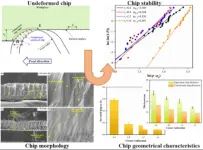(Press-News.org) If left unchecked, insect pests can devastate crops. To minimize damage and reduce the need for insecticide sprays, crops have been genetically engineered to produce bacterial proteins that kill key pests but are not harmful to people or wildlife. However, widespread planting of such transgenic crops has led to rapid adaptation by some pests. A new study in the Proceedings of the National Academy of Sciences reveals a novel genetic basis of resistance to transgenic crops in one of the most important crop pests in the United States.
Researchers from the University of Arizona Department of Entomology in the College of Agriculture, Life and Environmental Sciences used genomics to investigate the genetic changes causing resistance to transgenic crops in field populations of the corn earworm, also known as cotton bollworm or Helicoverpa zea. They discovered that in this voracious pest, field-evolved resistance was not associated with any of the 20 genes previously implicated in resistance to the pest-killing proteins in transgenic crops.
"The corn earworm is one the world's most challenging pests in terms of its ability to quickly evolve resistance in the field to genetically engineered crops. We identified 20 genes that harbor mutations conferring resistance to pest-killing proteins based on previous work with lab-selected strains of corn earworm as well as resistant field populations and lab strains of other lepidopteran pests," said senior study author Bruce Tabashnik, head of the U of A Department of Entomology. "We call these 20 genes 'the usual suspects.' Contrary to our expectations, in seeking the culprit for field-evolved resistance of corn earworm, none of the usual suspects were guilty."
A new tool in the never-ending battle with pests
To gain protection from the corn earworm and some other major caterpillar and beetle pests, crop plants have been genetically engineered to produce proteins from the common bacterium Bacillus thuringiensis, or Bt. Unlike broad-spectrum insecticides, Bt proteins are active against relatively few insect species. Whereas broad-spectrum insecticides are nerve poisons, Bt proteins can exert toxicity only if they are eaten and subsequently bind to specific gut receptors that are absent in most non-pest species, including humans. Because of their efficacy and safety, Bt crops are grown in dozens of countries on more than a quarter billion acres each year. In the United States in 2024, Bt varieties accounted for 86% of the corn and 90% of the cotton planted. However, evolution of resistance by pests such as corn earworm has decreased the benefits of Bt crops.
The corn earworm is one of the most economically significant pests in the United States, causing hundreds of millions of dollars in damage and costs annually. It attacks a wide range of crops, including corn, cotton, soybean and tomato.
A twist in the DNA
To analyze the genetic basis of field-evolved resistance of corn earworm, the U of A researchers collaborated with colleagues at Texas A&M University who had used bioassays to evaluate resistance by testing insects derived from the field.
"Bioassays are used routinely to determine if insects are resistant by exposing them to Bt proteins in the lab," said study co-author and U of A entomology professor Luciano Matzkin.
After bioassays are completed, the insects tested are usually discarded. In this innovative partnership, the insects from bioassays conducted at Texas A&M were frozen and sent to the U of A for DNA extraction and sequencing to enable scanning the entire genome for genetic differences between the resistant and susceptible corn earworm caterpillars. Including some previously sequenced specimens, the genomic analysis included 937 corn earworms from 17 sites in seven states across the southern United States, sampled from 2002 to 2020.
"We carefully examined 20 genes that affected how pests responded to Bt proteins in previous studies. Our evidence indicates changes in these genes are not causing resistance to Bt crops in wild populations of the corn earworm," explained Andrew Legan, a postdoctoral fellow at the U of A and first author of the study. "Instead, we found resistance was associated with a cluster of genes that was duplicated in some resistant field populations. But it remains a mystery as to how many of these genes contribute to resistance and how they confer resistance."
Despite not narrowing the cause of resistance to a single gene, researchers say the study provides an important reminder that the genetic basis of resistance can differ between the field and lab. This is a critical caveat for developing tools to monitor resistance in the field. The results also demonstrate how bioassays can be used with genomic analyses. As the study illustrates, genomic analyses of resistant and susceptible insects preserved from routine monitoring bioassays can help elucidate the genetic basis of field-evolved resistance, while the bioassay results can immediately determine the status of resistance in the field and help facilitate management decisions.
END
Not the usual suspects: Novel genetic basis of pest resistance to biotech crops
2024-11-04
ELSE PRESS RELEASES FROM THIS DATE:
Jill Tarter to receive Inaugural Tarter Award for Innovation in the search for life beyond earth
2024-11-04
Jill Tarter to Receive Inaugural Tarter Award for Innovation in the Search for Life Beyond Earth
November 4, 2024, Mountain View, CA – Renowned astronomer, Dr. Jill Tarter, SETI Institute co-founder and pioneering SETI researcher, will be honored with the inaugural Tarter Award for Innovation in the Search for Life Beyond Earth at the SETI Institute’s 40th Anniversary celebration on November 20, 2024, in Menlo Park, CA. This new award recognizes individuals whose projects or ideas significantly advance humanity’s search for extraterrestrial life and intelligence. The Tarter Award honors contributions ...
Survey finds continued declines in HIV clinician workforce
2024-11-04
November 4, 2024 — The supply of healthcare professionals available to provide HIV care continues to decline, even as the need for HIV care and prevention is expected to increase, reports a survey study in the November/December issue of The Journal of the Association of Nurses in AIDS Care (JANAC). The official journal of the Association of Nurses in AIDS Care, JANAC is published in the Lippincott portfolio by Wolters Kluwer.
"Our study provides new insights into the numbers and characteristics of clinicians who will be available to provide HIV care in the coming years. This information ...
Researchers home in on tumor vulnerabilities to improve odds of treating glioblastoma
2024-11-04
A team led by researchers at the University of Toronto has uncovered new targets that could be the key to effectively treating glioblastoma, a lethal type of brain cancer. These targets were identified through a screen for genetic vulnerabilities in patient-derived cancer stem cells that represent the variability found in tumours.
Glioblastoma is the most common type of brain cancer in adults. It is also the most challenging to treat due to the resistance of glioblastoma cancer stem cells, from which tumours grow, to therapy. Cancer stem cells that survive after a tumour is treated go on to form new tumours that do not respond to further treatment.
“Glioblastoma tumors have ...
Awareness of lung cancer screening remains low
2024-11-04
There is a lung cancer screening test that is saving lives – and yet most people who could be getting the test have never heard of it or never talked about it with a doctor.
“We’ve got a screening test that works. It works as well, if not better, than breast and colorectal cancer screening in terms of mortality reduction. It's one of the most life-saving things we have for a cancer that kills more people than either of those two combined,” said lung cancer pulmonologist Gerard Silvestri, M.D. And yet, he said, “Eighty percent of those eligible for this screening, regardless of race, education, ethnicity, health or income, hadn’t heard of or ...
Hospital COVID-19 burden and adverse event rates
2024-11-04
About The Study: In this cohort study of hospital admissions among Medicare patients during the COVID-19 pandemic, greater hospital COVID-19 burden was associated with an increased risk of in-hospital adverse effects among both patients with and without COVID-19. These results illustrate the need for greater hospital resilience and surge capacity to prevent declines in patient safety during surges in demand.
Corresponding Author: To contact the corresponding author, Mark L. Metersky, MD, email metersky@uchc.edu.
To access the embargoed study: Visit our For The Media website at this link https://media.jamanetwork.com/
(doi:10.1001/jamanetworkopen.2024.42936)
Editor’s ...
NSF NOIRLab astronomers discover the fastest-feeding black hole in the early universe
2024-11-04
Supermassive black holes exist at the center of most galaxies, and modern telescopes continue to observe them at surprisingly early times in the Universe’s evolution. It’s difficult to understand how these black holes were able to grow so big so rapidly. But with the discovery of a low-mass supermassive black hole feasting on material at an extreme rate, seen just 1.5 billion years after the Big Bang, astronomers now have valuable new insights into the mechanisms of rapidly growing black holes in the early Universe.
LID-568 was discovered ...
Translational science reviews—a new JAMA review
2024-11-04
About The Article: To help clinicians keep up with ongoing basic and translational science discoveries that affect the diagnosis and treatment of human disease, JAMA has launched a new series, “Translational Science Reviews.” These new article types are succinct and informative summaries of important basic science advances that are transforming diagnosis and treatment of human disease.
Corresponding Author: To contact the corresponding author, Mary M. McDermott, MD, email mdm608@northwestern.edu.
To access the embargoed study: Visit our For The Media website at this link https://media.jamanetwork.com/
(doi:10.1001/jama.2024.21146)
Editor’s Note: Please ...
How the keto diet could one day treat autoimmune disorders
2024-11-04
Scientists have long suspected the keto diet might be able to calm an overactive immune system and help some people with diseases like multiple sclerosis.
Now, they have reason to believe it could be true.
Scientists at UC San Francisco have discovered that the diet makes the gut and its microbes produce two factors that attenuated symptoms of MS in mice.
If the study translates to humans, it points toward a new way of treating MS and other autoimmune disorders with supplements.
The keto diet severely restricts carbohydrate-rich ...
Influence of tool corner radius on chip geometrical characteristics of machining Zr-based bulk metallic glass
2024-11-04
Different from traditional alloys, BMGs exhibit a unique atomic arrangement characterized by short-range order and long-range disorder at the atomic level. Such atomic structure leads to the absence of defects such as grain boundaries and dislocations, resulting in exceptional mechanical properties. The promising properties of BMGs have rapidly positioned them as a new class of structural and functional materials, showing great application potential in various fields including structural, energy and chemical engineering. In order to facilitate their engineering applications, research has reported their cutting characteristics from various aspects, ...
Megan Huisingh-Scheetz, MD, MPH, of the University of Chicago recognized with AFAR’s Terrie Fox Wetle Rising Star Award in Health Services and Aging Research
2024-11-04
New York, NY – The American Federation for Aging Research (AFAR), is proud to recognize the outstanding contributions of Megan Huisingh-Scheetz, MD, MPH, with the 2024 Terrie Fox Wetle Rising Star Award in Health Services and AgingResearch.
This award honors a health services researcher in an early or middle phase of his/her career who has already made importantcontributions with work that respects the value of multidisciplinary health services science and that ...




